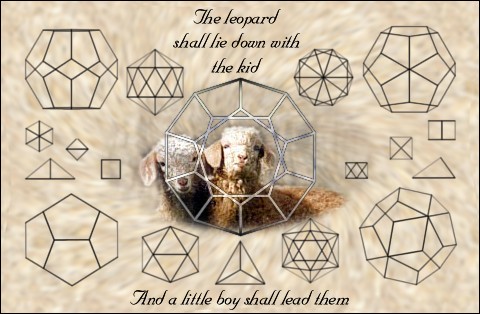The Angora Kids of Singing Falls
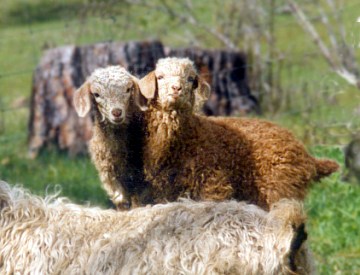
Curious, Wary and Daring when Mama is there
Capricious from birth, angora goat kids display their notorious proclivity to stun the unexpecting with their endless antics.
Angora goats are notorious for being one of the most delicate of all domestic livestock to rear. They put so much energy into their precious fleece that other aspects of their constitution suffer. The original imports from Turkey at the turn of the century were so susceptible to injury from the elements that most perished at sea on the voyage over the Atlantic.
TOP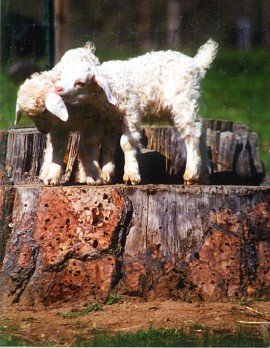
New born kids. Filled with a love for life and demonstrating their boisterous ways
Even more delicate are the newborn kids. They can endure cold. They can endure wind. But the combination of wind, cold, and wet will take them out in short order. Oregon in the NW USA is famous for long wet cool winters and springs. To care for them in this climate takes great skill, patience and experience.
In that respect Alexandra excels. She has the patience of a saint went it comes to the long hours of day and night tending to the young. Some require "tube feeding" or care concerning an upset stomach. Some are just weak when they are born and need a little extra boost of nutrients. Whatever the case the shepherd of the small herd must be there
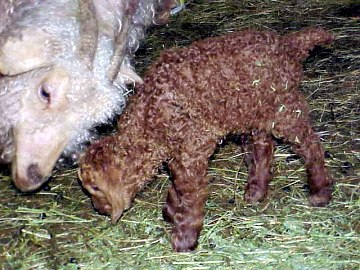
Doe and kid bonding at birth.
Mama relaxes a bit after giving birth, eating hay during the most important bonding process. Her little Kid copies mom's actions and pretends to eat hay also. A lot of subtle gentle sounds are made by momma for the little one to respond to. Visual contact is quintessential also. If this early phase of postpartum bonding doesn't go well the kid will die. Some first time mothers are so ill disposed because of the pain and travail of birthing that they reject the kid outright immediately. After the initial shock passes they will often settle into motherhood quite nicely. It is the shepherd's duty to bridge the gap during those times by feeding colostrum milked from momma or stored from the dairy goat in the freezer.
Always a sweet time for a shepherd, it is relaxing for us to just sit there in the sunshine after morning chores and watch the newborns follow their moms around. Little details like cleaning up the first sticky excretions, remnants from over rich colostrum, are vitally important. We are compelled to be observing and it helps us unwind a bit ourselves to see new life frolicking about.
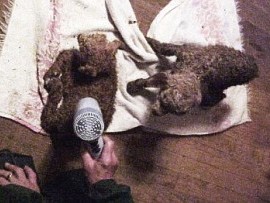
Born on a cold wet day
We often bring them in if temperatures outside are chilly. We dry them off with towels and then use the blow drier to complete the task until their newborn fleeces are completely dry. When dry and warm, they can go out with mom again at which time we watch to make sure they eat. These two kids were twin brothers. The one on the right became an eventual herd sire, King Tom Bombadil by name.
top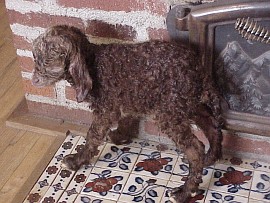
Will she survive the first few days?
There is great sadness when we lose kids, and unfortunately it occurs. During kidding season we do our utmost to make sure they get all they need in those first few hours. Sleep is a scarce commodity for us during that time of year. There is an intercom system that runs from the barn to the bed next to Stan' head. Warmth and food are essential. Our living room in the early cold spring often contains a kid or two that we are warming up.
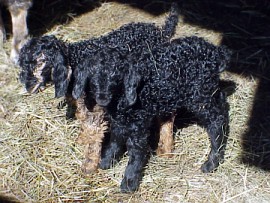
On their feet moments after birth
There is something about the black kids with those crimpy newborn fleeces that makes a shepherd do a double take. It is very rewarding to see kids "up and at 'em" as new borns. It is not accidental but the product of many years of careful breeding, to avoid inbreeding and select for fleece quality and hardiness.
top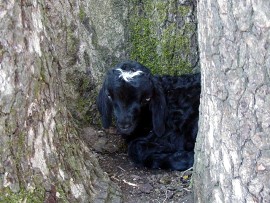
The yearly "hide and seek" event
This little tyke was hiding in a hollowed out base of an oak tree cluster on the edge the of the pasture. He later became one of the herd sires. Ace of Spades was his name and you'll find him in all his glory on our buck page. Though his fleece was not as curly as some when he was born, he soon acquired the kind of silvery fleece that Alexandra loves to spin. Even his adult clip was super fine and soft. It usually takes a year before a young buck can have his fleece "proven". It is then that he can be well examined for flaws in his mohair character or virtues in the same.
"hide and seek" is a game of torment the kids play with us every year. They think it's fun. The shepherd only thinks of the Foxes, Coyotes, Bobcats, Lions, Golden and Bald Eagles and much more that would love to slurp up this desirable delicacy. It's part of the job.
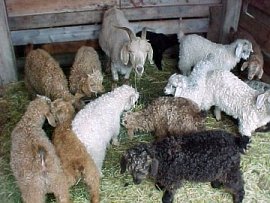
Red, black and white kids with their baby sitter, a doe named Silky.
The kids are in what is known as a creep feeder. This area is impossible for the bigger does to enter, so they are able to eat to their hearts' content. Silky was purposely placed in there with them because she was not feeling well. With tender care, she recovered nicely.
top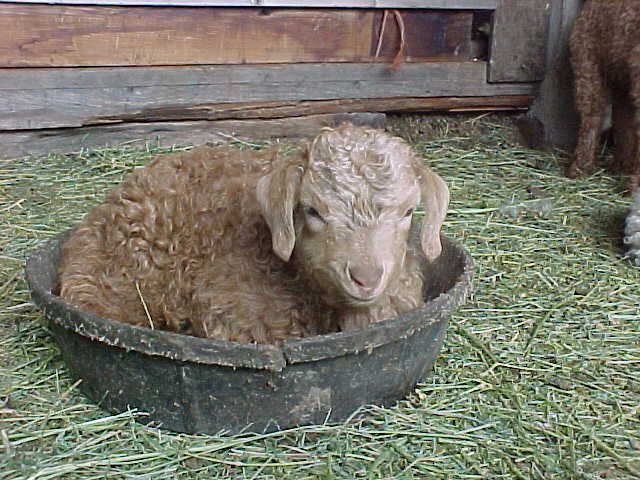
Little red buck curled up in a rubber food dish.
Life is good if one is warm, full and aware that mom will come running if I cry. The kids play hide and seek with with their mother's also. They're full of those shenanigans.
Many of the reddish kids will not stay red. For many centuries the angora goats were bred for pure white fleeces. Seeking to bring back natural color to the gene pool is taking many years from a large group of dedicated breeders. Color is what nature uses to either camouflage from predators or hide from prey, lure for feeding or attract for breeding.
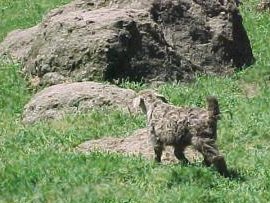
Kid blends in with boulders of the field.
This kid actually sports a color known widely in goat circles as taupe. The colored angora goats are painted hues from nature's paintbrush. As a species they are animals designated for predation.
top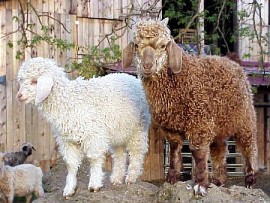
Little Poppy (registered white kid) left. Prince Theoden right.
Prince Theoden, who is yet another up and coming herd sire is finally old enough to perform his duty as a breeder (2007). Can't wait to see what kind of progeny spring forth, especially since we bred one special doe named Aduma (Willow x Coppertone) to him. We are looking for deep red hues in adult angoras and we're hoping he's a step in that direction.
Theoden was one of those kinds of buck kids that you must watch for a whole year. A striking presence as a kid, we wondered if he would have what it takes to make a herd sire. Indeed, he seems to. A nice deep copper red coloration complements a very fine fleece, not to speak of other virtues he holds.
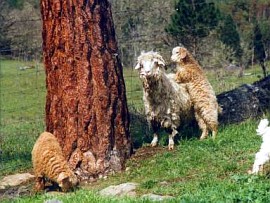
This picture reminds me of Dr. Seuss' poetry.
Hop on pop, we love to hop on pop! Actually here it is Hop on mom...
Many years have passed. The doe pictured is Bubba, one of our first does when we began to look for color in the herd. Can't believe all these years have rolled by. The two doe kids pictured are still with us, both nine years of age and counting. Their dam, of course, has gone on to goat heaven.
top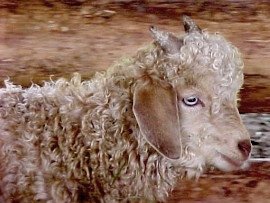
Tom Bombadil, is that you as a wee kid? I do believe it is...
If you could only see this big guy now. Like his sire, Willow, he is all muscle and sinew. All the girls blink long eye lashes at him when breeding season comes along, so we keep him in a pen made of log struts. I still recall when his sire, the great Willow, broke a log strut after ramming it with his horns all night. He was out with the girls in the morning smiling widely. We could not believe our eyes when we saw the size of the log he had rammed asunder. It just goes to prove that where there is a Willow, there is a way.
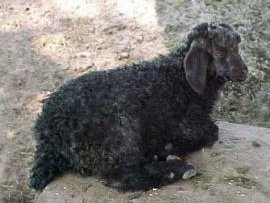
Ace of Spades growing bigger with a curly fleece beginning to appear.
Over the years we take photographs of our goats, especially loving to take photos of the kids. The truth of the matter is that we keep a great number of does, but most of the buck kids are either sold or made into sausage patties. I wish I could paint a rosier picture, but this is the name of the game. You can't keep every buck. You watch your herd closely and if a buck is exceptional, he stays. The ones who do manage to make the grade are very lucky fellers, indeed.
top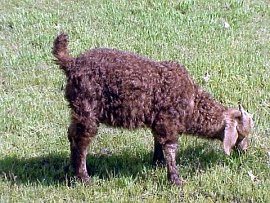
A mahogany hued kid
Another dark red kid munches lunch. This color is often referred to as mahogany. As the fiber elongates on the animal, the color almost inevitably lightens. Still pretty and still color, but lighter.
This is the time of their lives that they begin to put on weight. When pastures are green and lush, the kids' digestive systems have developed enough so that they can now absorb the nutrients found in the rich greenness that surrounds them.
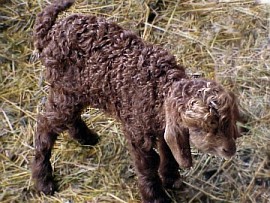
Theoden again, this time at the age of two days, all spunk and vinegar.
Do you recall the picture of Bubba and the two kids up above? The cinnamon red kid (not the climber) was named B-1. B-1 grew over the years and became a favorite doe in the herd. Theoden is B-1's son.
top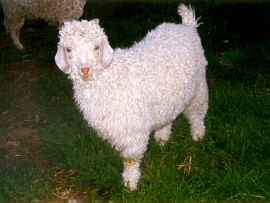
A registered white kid
Very precious, very lovely, white kid mohair. All curls and luster, white mohair is always a sought after commodity and kid is the softest and loveliest of all.
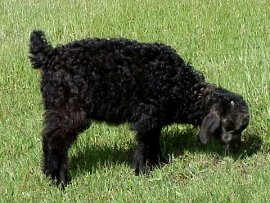
Lila, a very pretty black doe born in 2006
We love you, Lila! The black kid mohair seems to be the most precious mohair. Why? It is rare, for one. We have much silver hued mohair but few fleeces are black. Black kid fleece is rarer still, for the kid grows up and a black adult fleece takes its place. Alexandra has woven many scarves with black kid fleece and it seems each year there is still another order for one!
top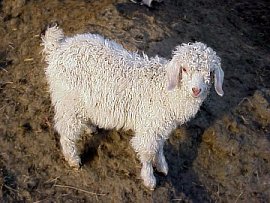
Little Poppy
Poppy is much older now and every once in awhile she must have her face shorn of curls because she inherited her sire's heavy face coverage and more often than not, cannot see through all the white mohair that curtains her eyes. However, in this picture, she can see quite well.
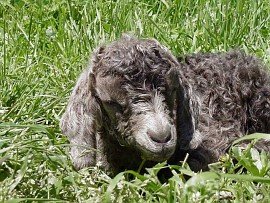
That taupe colored boy basking in the sunshine.
We have a few taupe colored goats in our herd, a special and unique color all its own.
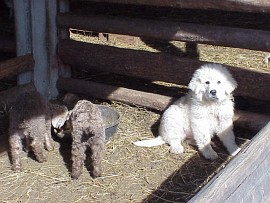
Luba, the baby livestock guardian dog, learning the ropes. Here we have her as an eight week old pup guarding her own little band of kid goats. She has come a long way in three years and now takes all her guard duties very seriously (as long as we keep up the feed schedule, the only requirement she makes of us.)
Luba is a purebred Great Pyrenees. She joins Tatra, our Polish Tatra/Maremma cross livestock guardian dog who came to this ranch before she did and taught her a few tricks of the trade. Both are jewels (though Luba is more a diamond in the rough.)
topSinging Falls Herd
Does of the Umpqua Goat Band
Bucks of Singing Falls
